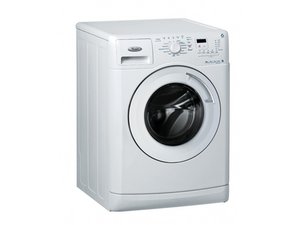I managed to repair the issue myself, it happened to be a mechanical issue in my case.
For anyone looking to solve this issue should it occur for them, below is what I discovered and how I fixed it.
Before attempting this repair, turn off power to the machine by either unplugging it or switching it's breaker off in your electric panel.
The door latch has a mechanical lock retainer (yellowish plastic) which normally prevents the electronic lock from being engaged while the door is open. This retainer has a rotating latch (also yellowish plastic) that normally should be in an "up" position and just behind the black plastic catch of the door latch body. Normally, when closing the door, the door's latching clip would engage the yellow lock retainer, allowing its powerful springs to move it out of the way of the electric locking mechanism. When opening the door again the door's latching clip would pull the yellow retainer back out, once again blocking the electric lock mechanism.
1) Open the door and remove the rubber boot ring by using a flathead screwdriver to pull down on the loop at the bottom of the ring behind the lip of the boot. Stretching the spring allows you to remove the whole ring easily. Pull off the boot just from the right side of the door. You do not need to unscrew anything but you will need access to the back of the door latch mechanism for step 3. This video shows how to remove the ring and get to the latch but you DO NOT need to remove the latch from the machine)
2) What happened to mine was the rotating latch got stuck halfway, forcing contact in the "2 wide prong" part of the circuit (which threw the F26 error). I resolved this issue by using a thin long flat head screwdriver to prod at the yellow lock retainer which snapped it into it's "free lock" position.
3) The door won't close properly while it is in that position, so the next step is to push on the yellow lock retainer from the back of the door latch assembly until the retainer stays in place, with the rotating latch back in the appropriate position as described above. (While doing this step, look at the door latch through the rectangular hole to see the rotating latch slip back into place as you press on the retainer lock from behind.)
Here's an image of the door latch assembly to help with referencing some of the parts I am talking about. Note in the "back" part of the image that the yellow lock retainer is slightly recessed in the assembly. If your lock retainer is flush with the white shell it is currently "free" and not blocking the electronic lock. The door will not close properly while it is in that position.
The door should now close properly. Get the power back on and try to run a cycle, F26 should be gone if this was your problem.
More Context:
The F26 error is a door closure malfunction. The door latch mechanism has three plugs, one that powers a solenoid for electronically locking the door (black cable, three wide prongs), one that detects that the door is closed (blue wire, two thin prongs) and one that detects that the electronic lock is engaged. (pink wire, 2 wide prongs) Your issue may differ from mine, but in the event that the door latch system is the problem it is actually relatively easy to diagnose and fix the issue. The latch assembly is not made from any complicated electronic parts if you need to remove the white plastic shell;⏎
- two sets of 2 metal contacts⏎
- a solenoid with three metal contacts and a steel bar in the middle⏎
- a thin metal cross (not sure what this is for)⏎
- a plastic slide sitting atop a parallel spring⏎
- a perpendicular spring inside a black plastic clip which is the cylinder that pokes out the other side⏎
- a u-shaped plastic lever⏎
- a yellow plastic lock retainer mechanism sitting on four springs⏎
- an anchor looking opaque plastic piece which is a tool for manually disengaging the electronic lock if it is accidentally in the locked position
Some additional notes: I checked the electrical connections using a multimeter prior to finding the mechanical issue and was able to determine there was nothing wrong with the control board or wires as they all gave me some kind of signal (either through ohm resistance or low voltage output with the machine on but not running a cycle) The only one that gave me no signal, no matter what, was the "2 wide prong" connector on the door latch assembly because it was shorted by the mechanical issue. I only figured this out after I opened the assembly and fully learned how the door latch works.
crwdns2934105:0crwdne2934105:0
crwdns2934113:0crwdne2934113:0
crwdns2915270:0crwdne2915270:0
crwdns2889612:0crwdne2889612:0
0

 1
1 

 388
388  1.5crwdns2936485:0crwdne2936485:0
1.5crwdns2936485:0crwdne2936485:0